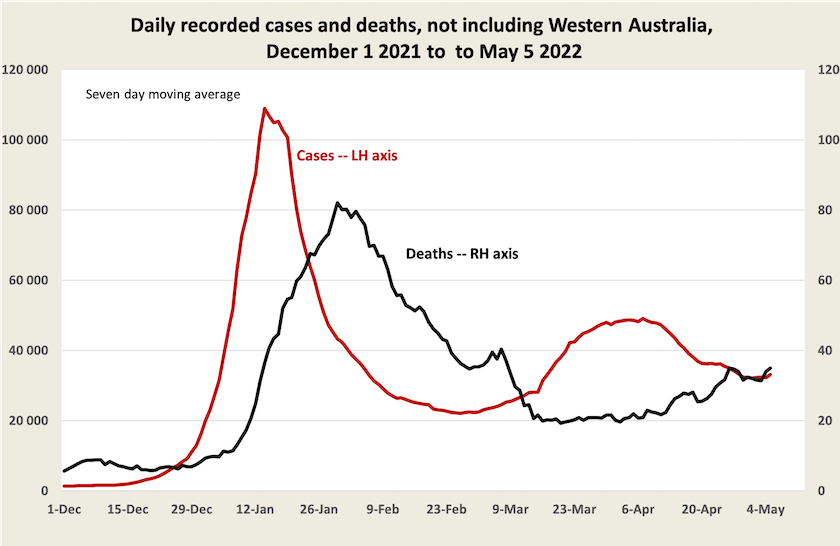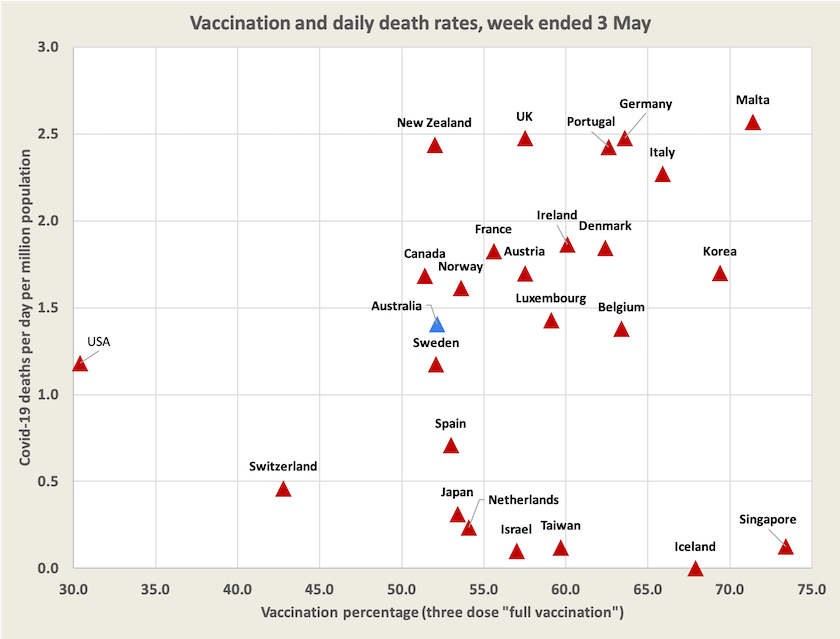That bloody pandemic
Living with Covid: what does it mean?
Worldwide, at least for those countries that keep records, cases and deaths are falling, but, as the WHO has pointed out, there has been a vast under-statement of deaths from Covid-19. According to country reports, collated by the WHO, there have been 6.2 million Covid-19 deaths worldwide, but based on analysis of excess deaths the actual number lies in the range 13.3 to 16.6 million. Only in high-income countries do the official and excess death figures tally.[1]
In a few countries that had successful containment policies in the pandemic’s early stages, cases are running at a high level. Apart from a number of small island nations, where the virus is now spreading rapidly, Australia and New Zealand are the only countries where daily cases are 1500 per million or higher.[2]
The graph below shows cases and deaths in Australia, excluding Western Australia, which because of its strict border controls, did not experience the December-January spike. The trajectory of cases in all other states and territories has been similar.

Note the lag, of about three weeks, between recorded cases and deaths. The wave of infections that passed through in late March and early April, coinciding with lifting of restrictions, Easter holidays, and the onset of cold weather, has subsided, and deaths following that wave should soon subside. The death rate per recorded case (with a 3 week lag) is around 0.08 percent, or 1 in 1300.
Our daily death rate per million population is around 1.5, which is reasonably low in comparison with other countries, considering our comparatively low level of third-dose vaccination. Vaccination levels and daily deaths per million for “developed” countries are shown in the scatter diagram below.

A daily death rate of 1.5 per million equates to a daily rate across our 26 million population of about 40, or 15 000 a year. That’s comparable to deaths from ischaemic heart disease (16 000) and dementia (15 000), or 14 times our road deaths (1 100).[3]
The ABC’s Matt Wordsworth asks Are we at a point where Australians tolerate people dying from COVID-19?. Perhaps the message we have picked up from government is that the virus is over.
In a short session on the ABC’s PM, three public health experts and epidemiologists warn that the virus is still with us. Peter Doherty says “when the government decided this is over, it forgot to tell the virus”. After two years we have become sick of Covid-19 and want it out of our way, and even though it should be an election issue (having regard to the Morrison government’s failures in ordering vaccines and neglecting aged care homes), it is not on parties’ agenda. Ignoring it, however won’t make it go away. “We have not thought it through” he says.
That means we are not learning the public health lessons from Covid-19, will be ill-prepared for the next Covid variant or new pandemic, and are taking unnecessary risks. Doherty concludes with a public health message, particularly for older people and for those with compromised immune systems. In view of the long-term consequences of Covid-19 they should register their illness as soon as they test positive it so that they can obtain anti-viral medication. (4 minutes)
1. Even in “developed” countries data is becoming more patchy. Although authorities in these countries endeavour to keep good records, many cases go undetected and many people with Covid-19 die of other causes, which means case and death figures need to be considered with caution. ↩
2. Average daily cases per million in the 7 days to May 3: Australia 1525, New Zealand 1501. Others > 1500, all girt by sea: Cook Islands 3426, Montserrat 1565, Palau 1655, Saint Pierre and Miquelon 1796, Samoa 1564. ↩
3. ABS Causes of Deaths. ↩